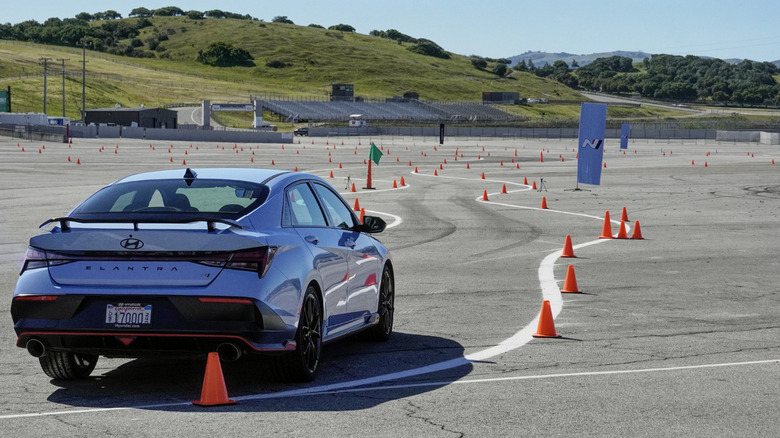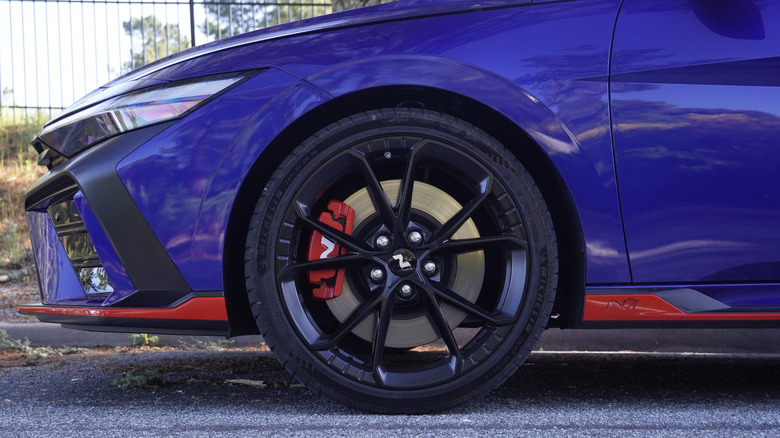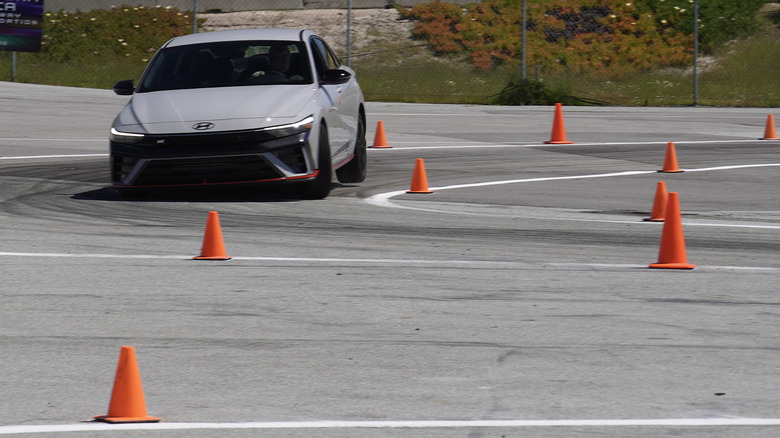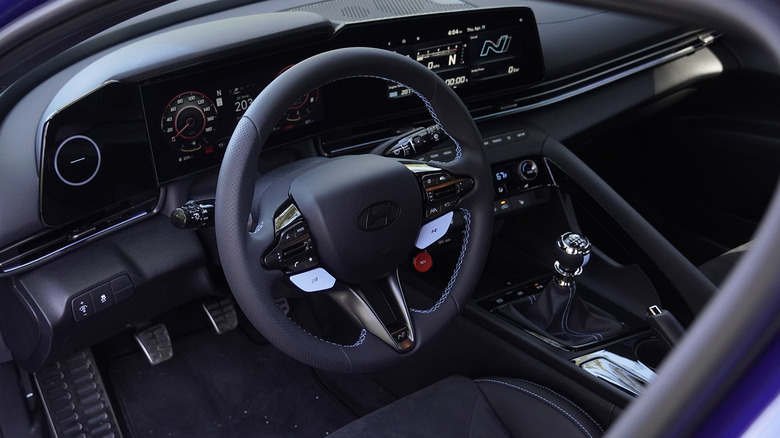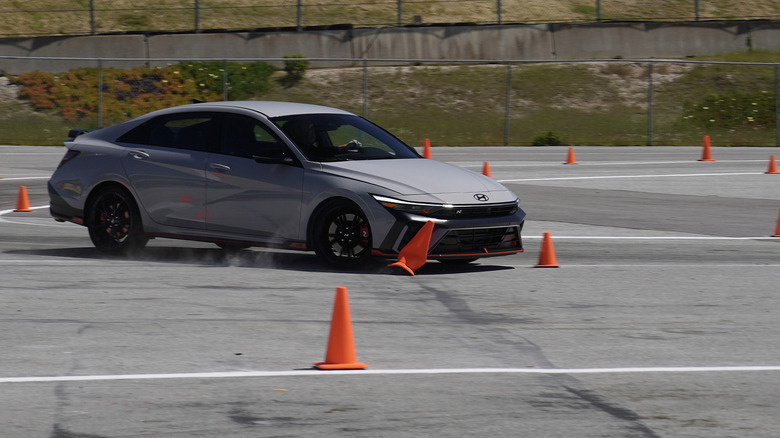2024 Hyundai Elantra N First Look: The Best Bargain In Sports Sedans Gets An Update
As a little bonus to top off a surprisingly spectacular track debut of the Ioniq 5 N at WeatherTech Raceway Laguna Seca, Hyundai also brought a small fleet of the updated 2024 Elantra N for autocross and road drive testing. The front-wheel-drive Elantra continues to build on Hyundai's successful N recipe, which already represented one of the best deals on the market for a budget sport sedan.
Much of that recipe carries forward to 2024, including the peppy 2.0-liter turbocharged inline-four engine and the choice between a six-speed manual transmission or an eight-speed dual-clutch automatic. Regardless of two or three-pedal configuration, the Elantra N still affords drivers the chance to fiddle with just about every possible setting, including shock damper firmness, electrically controlled limited-slip differential engagement, and steering assist. The manual car still offers rev-matching, too, while the DCT retains the N Grin Shift button.
2024 model year updates focus on the little details
The 2024 model year's updates largely focus on dialing in suspension dynamics to better harness every last ounce of the Elantra N's 276 horsepower and 289 lb-ft of torque. Reinforced engine-mount membranes promise a reduction in vibrations throughout the chassis and improved shifting precision. What Hyundai calls "G-bushings" receive reinforcement to improve the connection between the wheel hub, control arms, and unibody. And the rear suspension bushings switch from rubber to urethane to finetune both high-speed stability and low-speed absorption of undulations in road surfaces.
Lighter forged alloy wheels cut 8.25 pounds of unsprung weight at each corner, for total weight savings of 33 pounds in the most important place to do so. The electronically assisted steering—already one of the best setups in the game—also gets a lower friction steering joint and ECU recalibration. The suspension adjustment software available on the N's 10.25-inch touchscreen received reprogramming to take all the revisions into consideration, from track performance to comfortable daily driving, while a subtly redesigned front bumper improves airflow through the engine bay and radiators, as well as the braking system, for improved heat dissipation during spirited drives.
Autocross fun in the 2024 Elantra N
On a relatively long autocross course that Hyundai coned off in Laguna Seca's paved infield, all the subtle revisions to the Elantra N certainly don't detract from the fun factor. Under hard acceleration, cornering, and braking, the chassis still dips and rolls playfully, lifting up on three wheels regularly around a few of the tightest turns. Tire squeals and chattering through understeer echoed off the paddock walls, as the exhaust–opened up fully in Sport mode–snorts and burbles from throttle liftoff overrun.
Hyundai proudly proclaims that understeer actually makes the internal-combustion N models—the Elantra, as well as the Kona and erstwhile Veloster—more enjoyable, though finding the right balance between power delivery and balance for an autocross day requires more than a few laps. Braking more slowly while avoiding any ABS intervention actually helps to shave precious tenths of seconds off the clock, counterintuitively for most drivers accustomed to rear or all-wheel drive.
The goal becomes keeping the front wheels under load at all times, through tight corners and longer transitions alike, so shifting up into third to stay lower in the turbo-four's rev range can actually help. Especially in the DCT car, which features slightly shorter gear ratios than the six-speed stick shift and can prompt a bit of traction and stability control intrusion more easily.
Road driving better reveals the model year updates
Though still somewhat soft for an autocross car, out on the public roads of Monterey, the Elantra N's 2024 updates produce a noticeably firmer and more precise ride across every drive mode. The front axles, especially, communicate more directly through the steering wheel thanks to the firmer bushings and revised steering components. But the whole chassis rides firmer and flatter than ever before, for clear gains in dynamics while driving hard—but also, as a trade-off, somewhat impinging on the smoother end of damping characteristics while cruising at the pace of a daily driver.
Ripping the Elantra over the Laureles Grade after a quick jaunt in the Ioniq 5, on the other hand, reveals the absolute magic that the N team works on every vehicle to wear the badge. The relative engagement of both shines through, even if the EV's rowdier nature reaches a much more serious level of pace and requires far more attention to keep in line.
Slight revisions help the Elantra N keep up with the competition
For fans of the manual gearbox willing to live with front-wheel-drive torque steer, the Elantra N might just take the cake for value at a starting price of $33,700. The DCT steps that sticker up to $35,200 but, to an extent, lacks some of the appeal if driving hard regularly fits into the equation. For dailying in traffic, with occasional canyon carving or autocross stints in mind, the automatic will still serve its purpose well.
Hyundai probably didn't need to make any changes to the Elantra N for the new model year. And yet, doing so helps to bolster its positioning above the Honda Civic Si, which slots in a bit cheaper at $30,195. And even subtle steps up in the performance arena help to make the Elantra N more attractive relative to the Civic Type R's $45,890 starting sticker. Regardless of transmission choice, the new Elantra N still delivers the fun factor in spades, just with a bit more of an edge now to constantly remind owners just what the N stands on every single drive.
